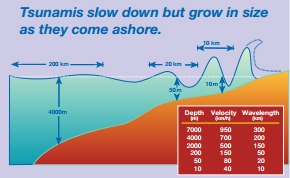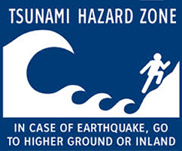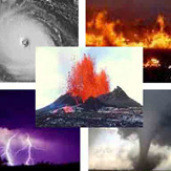
A tsunami [soo-nah´-mee] is a series of huge, destructive waves caused by an undersea disturbance from an earthquake, volcano, landslide, or even a meteorite.
As the waves approach the shallow coastal waters, they appear normal and the speed decreases.
Then, as the tsunami nears the coastline, it turns into a gigantic, forceful wall of water that smashes into the shore with speeds exceeding 600 miles per hour (965 km/h)!
Usually tsunamis are about 20 feet (6 m) high, but extreme ones can get as high as 100 feet (30 m) or more!
A tsunami is a series of waves and the first wave may not be the largest one, plus the danger can last for many hours after the first wave hits. During the past 100 years, more than 200 tsunamis have been recorded in the Pacific Ocean due to earthquakes and Japan has suffered a majority of them.
The Pacific Ocean tsunami warning system was put in place back in 1949. As of June 2006, the Indian Ocean has a tsunami warning system, and NOAA expanded the Pacific system to include the Caribbean, the Gulf of Mexico and areas of the Atlantic around the U.S. coast as of mid-2007.
Did you know...
...a tsunami is not a tidal wave - it has nothing to do with the tide?
...another name used to describe a tsunami is “harbor wave”?
...“tsu” means harbor and “nami” means wave in Japanese?
...sometimes the ocean floor is exposed near the shore since a tsunami can cause the water to recede or move back before slamming in to shore?
...tsunamis can travel up streams and rivers that lead to the ocean?

BEFORE A TSUNAMI:
Learn the buzzwords - Learn words used by the Tsunami Warning Center for tsunami threats...
- Advisory - an earthquake has occurred in the Pacific basin which might generate a tsunami
- Watch - a tsunami was or may have been generated, but is at least 2 hours travel time from Watch area
- Warning - a tsunami was / may have been generated and could cause damage to Warning area - should evacuate
Learn risks - If new to area, call local emergency management office and ask what the warning signals are and what to do when you hear them. Coastal areas less than 25 feet above sea level and within a mile of shoreline along coasts are at greatest risk.
Make a plan - Develop a Family Emergency Plan (e.g. establish meeting places, list of emergency contact #s, out of state contact person, etc) and Disaster Supplies / Grab & Go Kits.
Listen - Make sure you have a battery-operated radio (with spare batteries) for weather forecasts and updates. (Radios like NOAA’s Weather Radio have a tone-alert feature that automatically alerts you when a Watch or Warning has been issued.)
Water signs - If near water or shore, watch for a noticeable rise or fall in the normal depth of coastal water - that’s advance warning of a tsunami so get to high ground. Also - if water pulls away from shoreline and exposes sea floor - run to higher ground ASAP!!
Feeling shaky...? - If you feel an earthquake in the Pacific Coast area (from Alaska down to Baja), listen to the radio for tsunami warnings.
Is that it...? - Don’t be fooled by the size of one wave - more will follow and they could get bigger … and a small tsunami at one beach can be a giant wave a few miles away!
Be ready to evacuate - Listen to local authorities and leave if you are told to evacuate.
DURING A TSUNAMI:
Leave - If you are told to evacuate, DO IT! Remember - a tsunami is a series of waves - the first one may be small but who knows what the rest will bring. Grab your Disaster Supplies Kit and GO!
IF ON OR NEAR SHORE - Get off the shore and get to higher ground quickly! Stay away from rivers and streams that lead to the ocean since tsunamis can travel up them too. You cannot outrun a tsunami ... if you see the wave it’s too late!
IF ON A BOAT - It depends where you are -- either get to land or go
further out to sea ...
- In port - May not have time to get out of port or harbor and out to sea - check with authorities to see what you should do. Smaller boats may want to dock and get passengers and crew to land quickly.
- In open ocean - DO NOT return to port if a tsunami warning has been issued since wave action is barely noticeable in the open ocean! Stay out in open sea or ocean until authorities advise danger has passed.
Don’t go there - Do NOT try to go down to the shoreline to watch and don’t be fooled by size of one wave - more will follow and they could get bigger so continue listening to radio and TV.
AFTER A TSUNAMI:
Listen - Whether on land or at sea, local authorities will advise when it is safe to return to the area -- keep listening to radio and TV updates.
Watch out - Look for downed power lines, flooded areas and other damage caused by the waves.
Don’t go in there - Try to stay out of buildings or homes that are damaged until it is safe to enter and wear sturdy work boots and gloves when working in the rubble.
Strange critters – Be aware that the waves may bring in many critters from the ocean (marine life) so watch out for pinchers and stingers!
RED or GREEN sign in window – After a disaster, Volunteers and Emergency Service personnel may go door-to-door to check on people. By placing a sign in your window that faces the street near the door, you can let them know if you need them to STOP HERE or MOVE ON.
Either use a piece of RED or GREEN construction paper or draw a big RED or GREEN “X” (using a crayon or marker) on a piece of paper and tape it in the window.
-- RED means STOP HERE!
-- GREEN means EVERYTHING IS OKAY…MOVE ON!
-- Nothing in the window would also mean STOP HERE!
Insurance - If your home suffers any damage, contact your insurance agent and keep all receipts for clean-up and repairs.
Mold - Consider asking a restoration professional to inspect your house for mold. Also check out www.epa.gov/mold
Some additional things to check and do...
- Check electrical system (watch for sparks, broken wires or the smell of hot insulation)
- Check appliances after turning off electricity at main fuse and, if wet, unplug and let them dry out. Call a professional to check them before using.
- Check water and sewage system and, if pipes are damaged, turn off main water valve.
- Throw out food, makeup and medicines that may have been exposed to flood waters and check refrigerated foods to see if they are spoiled. If frozen foods have ice crystals in them then okay to refreeze.
- Throw out moldy items that are porous (like rotten wood, carpet padding, furniture, etc.) if they’re too difficult to clean and remove mold. Remove standing water and scrub moldy surfaces with non-ammonia soap or detergent, or a commercial cleaner, rinse with clean water and dry completely. Then use a mixture of 1 part bleach to 10 parts clean water to wipe down surfaces or items, rinse and dry.
- Secure valuable items or move them to another location, if possible
Download a free 68-pg portion of USFRA's custom Family Preparedness ebook and order full ebook on USFRA.org
Source: IT'S A DISASTER!
Additional resources...


